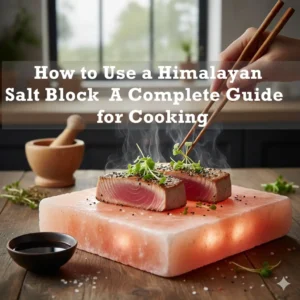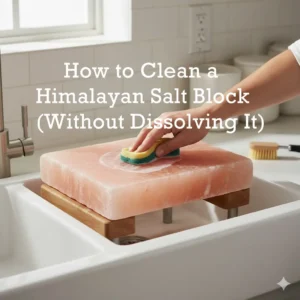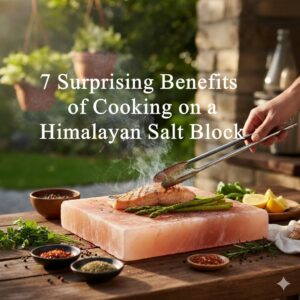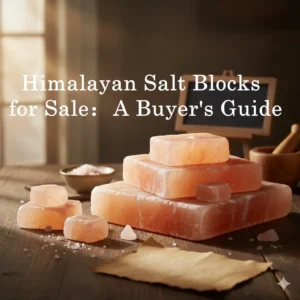A Himalayan salt block isn’t just visually striking—it’s an efficient cooking surface rooted in precise thermodynamics. Composed of dense crystalline minerals, it absorbs and radiates heat evenly for exceptional browning and consistent searing. Its hygroscopic nature draws surface moisture from food, accelerating the Maillard reaction to form a crisp, flavorful crust with minimal seasoning. This article explores how salt block searing works and how to harness its heat retention and mineral chemistry for refined, professional‑grade results at home or in a test kitchen.

Tools and Materials for Effective Salt Block Searing
Before searing on a Himalayan salt block, it’s essential to have the right equipment for safety, precision, and consistent thermal control. Each item below supports even heating, safe handling, and block longevity—key elements for achieving consistent thermodynamic performance and professional cooking results.
- A high-quality Himalayan salt block, ideally 1–2 inches thick, sourced from the Khewra Salt Mine for its density and thermal stability.
- A stable heat source that can gradually reach 450–500°F (230–260°C), such as a gas burner or electric stovetop, ensuring even heating and preventing thermal shock.
- Tongs or a spatula for turning food and maintaining distance from the hot surface.
- Heat-resistant gloves or mitts for safely transferring the block during heating or serving.
- A scraper or brush designed for salt blocks to remove residue after use without water, maintaining the block’s structure and durability.
With these tools in place, the cooking process remains controlled and efficient, allowing the block’s heat capacity and hygroscopic properties to drive consistent searing, balanced mineral transfer, and superior flavor development.
Step-by-Step Guide to Searing on a Himalayan Salt Block
Step 1: Gradually Heat the Salt Block
Proper heating is essential for both safety and performance when cooking on a Himalayan salt block. Place the block on a cold grill or stovetop set to low heat to begin. This gradual start prevents thermal shock that could crack the block’s crystalline structure. Over thirty to forty-five minutes, slowly increase the temperature in stages until it reaches 450–500°F (230–260°C).
At this point, the block’s dense composition allows it to maintain steady, evenly distributed heat. Controlled heating ensures the surface temperature remains uniform, creating an ideal foundation for precise searing and crisp, caramelized crust formation.
Step 2: Prepare the Food and Begin Searing
Pat each ingredient completely dry before cooking. Removing surface moisture enables the salt’s hygroscopic surface to create an ultra-dry environment that accelerates the Maillard reaction—the chemical process responsible for browning and flavor development. On the heated salt, this reaction begins almost instantly, forming a deep, golden crust while retaining internal moisture.
Use tongs to arrange food evenly across the block for full thermal contact. The consistent high temperature allows efficient heat transfer, ensuring even browning and minimizing over-searing. Turn each piece once it develops a rich brown color. This balance of thermal stability and surface dryness delivers a crisp exterior and tender interior with well-integrated seasoning.
Step 3: Remove and Serve
After searing, lift food gently using tongs. Certain dishes can be presented directly on the warm block for clean, natural styling and gentle heat retention. If transferring to a plate, handle the block with care—it retains heat for an extended period due to its substantial thermal mass.
Allow the block to cool gradually to room temperature before cleaning or storage. Sudden temperature changes or contact with water can cause microfractures. When cooled and cleaned properly, the block retains its structural integrity and mineral-rich surface, ready for continued high-heat performance and subtle flavor enhancement in future use.
Premium Himalayan Salt Blocks Tailored for Your Business
Partner with Jilin Ever Creation to source natural, FDA-approved pink Himalayan salt products engineered for grilling, serving, and presentation. Customize dimensions, packaging, and branding to align with your business goals, supported by global shipping and flexible order volumes for food service, retail, and hospitality applications.
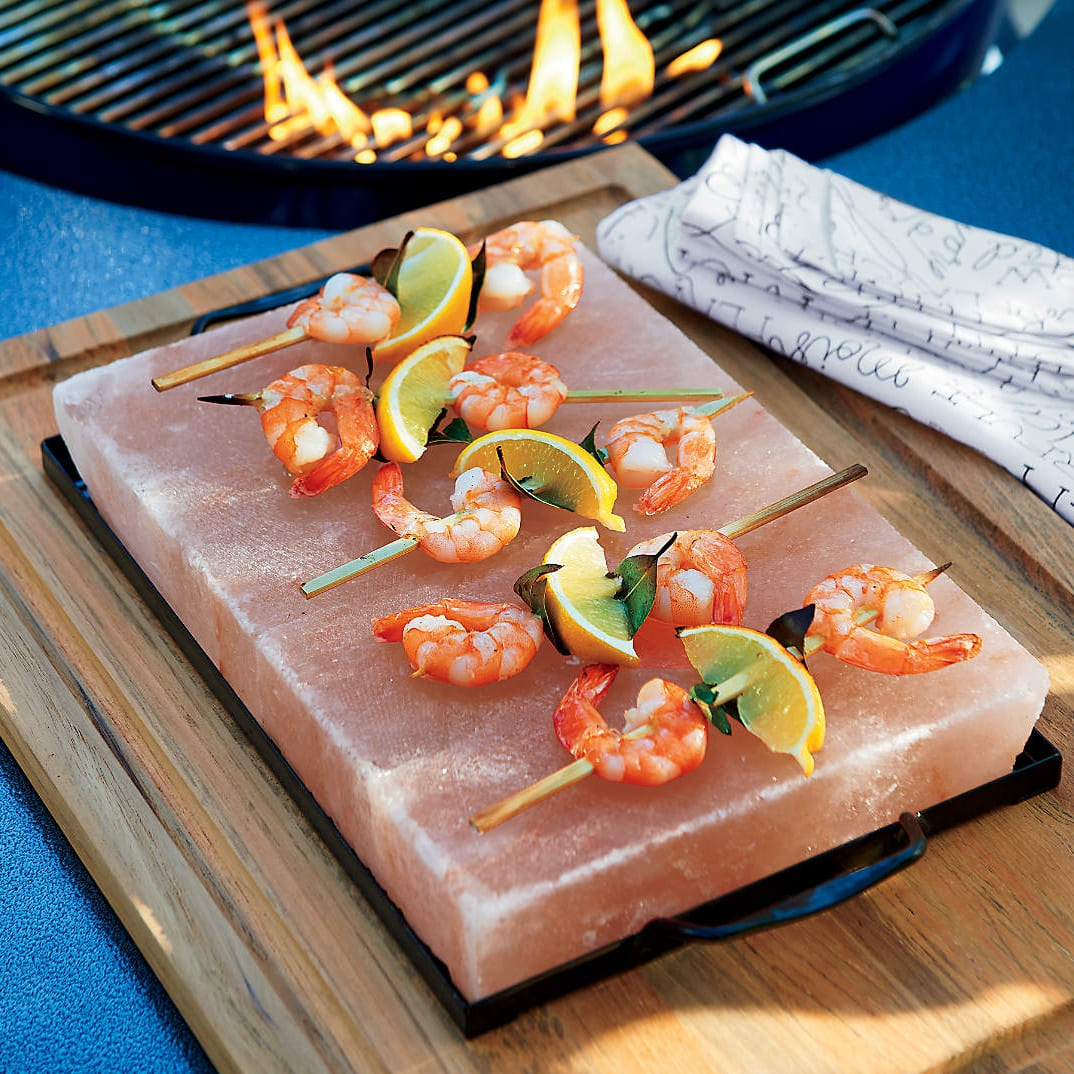
Heat Retention and Thermal Properties of Himalayan Salt Blocks
Himalayan salt blocks demonstrate unique thermodynamic properties that make them ideal for high‑temperature cooking. Once heated, their dense crystalline matrix absorbs and retains significant thermal energy, sustaining surface temperatures around 450–500°F with minimal fluctuation. This high heat capacity provides a consistently hot, stable surface—essential for achieving clean, even sears and uniform internal cooking.
The block’s tightly bonded lattice ensures even heat conduction across its entire surface. Instead of developing hot spots, energy disperses uniformly, producing consistent browning wherever food makes contact. This balance minimizes overcooking and promotes a uniform color and texture across ingredients.
At the microscopic level, salt’s hygroscopic nature interacts with food moisture, drying the surface rapidly and activating the Maillard reaction sooner. The result is a deep, flavorful crust formed through the combined effects of sustained heat retention, steady conduction, and precise surface dryness—a thermodynamic synergy that distinguishes salt block searing from traditional metal cookware.
Moisture Interaction: How Salt Blocks Create a Hyper-Dry Surface
When food contacts a heated Himalayan salt block, the salt’s hygroscopic property instantly draws moisture from the ingredient’s surface. This swift extraction produces an exceptionally dry interface where water evaporates almost immediately. The reduced surface moisture raises the temperature threshold, enabling the Maillard reaction—where amino acids and sugars combine under heat—to activate faster and with greater intensity.
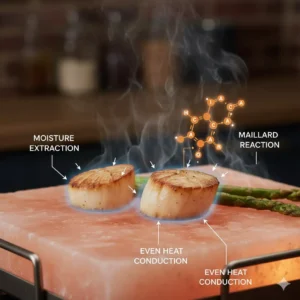
This accelerated reaction develops the golden crust and deep umami character that define expertly seared food. Because the block retains and distributes heat evenly, browning occurs uniformly without scorching. Meanwhile, only the superficial moisture is removed; internal juices remain sealed within the protein or vegetable matrix, maintaining a tender interior beneath the crisp exterior.
Thermodynamically, the balance of heat and moisture on a salt block forms a controlled microenvironment optimized for energy transfer and browning chemistry. Beyond its technical precision, this process gently infuses trace minerals into the food, creating a clean, well‑rounded salinity that enhances flavor without overwhelming it.
Mineral Transfer and Flavor Enhancement in Salt Block Cooking
When food meets the heated surface of a salt block, surface moisture reacts with the crystalline salt, dissolving minute concentrations of minerals such as calcium, potassium, and magnesium. These ions migrate gradually into the food, integrating flavor at a molecular level. The result is a measured mineral infusion that enhances taste without overwhelming it.
Unlike traditional surface salting, mineral transfer from the block distributes seasoning evenly throughout the outer layers of the food. Each bite maintains consistent salinity that enriches rather than masks the ingredient’s natural flavor profile, yielding a balanced, refined finish with subtle mineral depth.
The unique mineral composition of Himalayan salt further elevates this effect, imparting soft, layered notes and a rounded flavor profile. Thermodynamically, the block’s heat stability and hygroscopic properties synchronize to manage seasoning, moisture, and texture development in one precise cooking process.
Cleaning, Maintenance, and Safe Handling of Salt Blocks
Proper maintenance preserves a salt block’s structural integrity and ensures reliable performance through repeated high‑heat use. Sudden temperature changes can fracture the crystalline lattice, so always allow the block to cool gradually to room temperature before cleaning or storage.
After each use, scrape off food residue with a dry spatula or a slightly damp, non‑abrasive brush. Never soak or immerse the block in water—its hygroscopic nature makes it prone to surface erosion. If needed, wipe lightly with a damp cloth and let it air‑dry completely.
Once fully dry, wrap the block in a clean cloth or plastic film and store it in a low‑humidity area. This minimizes moisture absorption, maintains its natural antimicrobial surface, and extends its lifespan across numerous cooking cycles.
Frequently Asked Questions About Salt Block Searing
Why does a Himalayan salt block retain heat longer than a metal pan?
A Himalayan salt block’s dense crystalline structure has a high heat capacity, allowing it to absorb and store substantial thermal energy. Once heated, it releases that energy gradually, maintaining steady surface temperatures for extended periods. Metals, in contrast, heat and cool rapidly, often causing temperature fluctuations during searing.
How does salt’s hygroscopic property accelerate the Maillard reaction?
Because salt is hygroscopic, it draws moisture from the food’s surface almost instantly. This creates a drier contact layer where the Maillard reaction begins more rapidly, forming a richly colored crust with enhanced flavor and aroma. The interior remains juicy, but the exterior browns more efficiently than in conventional pan cooking.
Does a salt block provide completely even heat distribution?
Salt blocks conduct heat evenly across their surface, though minor variations can occur depending on thickness and heating method. Gradual, staged heating helps equalize temperature and prevents internal stress fractures. When preheated properly, the surface functions as a stable, uniform thermal plate for consistent searing.
Do minerals from the block actually transfer into the food?
Yes, but in controlled amounts. As surface moisture dissolves trace minerals like calcium and magnesium, they migrate into the food’s outer layer. This results in balanced seasoning with subtle mineral depth rather than an overtly salty coating, distinguishing it from traditional surface salting.
How is salt block searing scientifically different from cooking on cast iron?
Salt block searing combines stable heat retention with active chemical interaction. Its hygienic, hygroscopic surface extracts moisture, promotes mineral transfer, and initiates the Maillard reaction through a thin saline film. Cast iron also retains heat effectively but does not influence moisture chemistry or flavor development in the same way.
Final Thoughts
Cooking on a Himalayan salt block unites culinary creativity with scientific precision. Its high heat capacity and uniform thermal distribution produce an ideal surface for rapid Maillard reaction, generating a deep, even crust while retaining internal moisture. The block’s hygroscopic qualities pull surface water away, ensuring proteins and vegetables caramelize evenly rather than steam.
Each sear subtly transfers trace minerals that enhance natural flavor without oversalting. With gradual heating and attentive handling, salt block cooking becomes a dependable, science‑backed method that refines traditional searing. For professionals and enthusiasts alike, it offers a distinctive way to merge thermodynamics, control, and flavor in every preparation.


